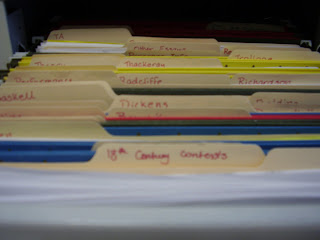 With comprehensive exams looming on my academic horizon, how I organize my information has become rather important. For each text, I type notes, copy paste plot summaries from the LRC, and allow them to remain digital texts, which can be pulled up, hyperlinked, and added to at a moment's notice. However, I find that I have collected a number of physical notes and handouts that must be retained. I recently shifted my folders from organizing the papers by the class I was in that produced them, to organizing them by author (or, in some cases, topic, such as "Romantic poets"). This has been fairly productive, and I think, will be far more useful as I begin to study for exams.
With comprehensive exams looming on my academic horizon, how I organize my information has become rather important. For each text, I type notes, copy paste plot summaries from the LRC, and allow them to remain digital texts, which can be pulled up, hyperlinked, and added to at a moment's notice. However, I find that I have collected a number of physical notes and handouts that must be retained. I recently shifted my folders from organizing the papers by the class I was in that produced them, to organizing them by author (or, in some cases, topic, such as "Romantic poets"). This has been fairly productive, and I think, will be far more useful as I begin to study for exams. As a very visual learner, I find it quite helpful to have useful information displayed above my desk, which has made necessary a rather ridiculous number of cork boards. On the left, vertical board, I keep information regarding writing - here are handouts for proofreading given by professors, my own personal editing checklist generated during my thesis-writing days, and a rather crushing but completely helpful email print out from a professor relating the (large) number of errors in the paper I had turned in to him - I am, I hope, unlikely to make those same mistakes again.
As a very visual learner, I find it quite helpful to have useful information displayed above my desk, which has made necessary a rather ridiculous number of cork boards. On the left, vertical board, I keep information regarding writing - here are handouts for proofreading given by professors, my own personal editing checklist generated during my thesis-writing days, and a rather crushing but completely helpful email print out from a professor relating the (large) number of errors in the paper I had turned in to him - I am, I hope, unlikely to make those same mistakes again. On the right, horizontal board, I have handouts relating to the 19th century - timelines, a handy chart that shows the relative conversions of 19th centruy British money, a map of England, copies of 18th century woodcuts, and so on. This makes it rather easier to quickly access such information as "where the devil is Wessex?" or "what in the world is a groat?" or whether or not the reform bill had passed before a particular novel had been published. I suppose there are other, neater ways, of organizing such information, but I rather like my collaged, hodge-podge of useful advice and obscure historical fact.
No comments:
Post a Comment